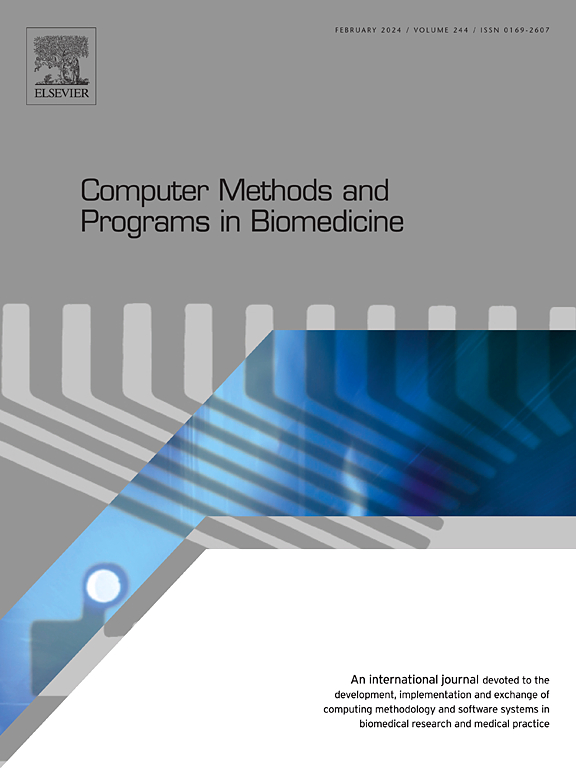A parametric study of motion and attachment to capillary walls of circulating tumor cells (CTCs) interacting with non-activated and activated platelets
IF 4.9
2区 医学
Q1 COMPUTER SCIENCE, INTERDISCIPLINARY APPLICATIONS
引用次数: 0
Abstract
Background and objective
Our previous research examined the biophysical conditions required for CTC arrest using a custom-built solid–fluid 2D axisymmetric computational model. Application of that model resulted in calculating the limiting conditions under which a CTC can pass through a narrowed capillary with a platelet attached to the capillary wall. This paper is a step forward in determining the effects of a selected set of parameters: number of platelets, CTC diameter, stiffness, and ligand-receptor bond stiffness of the CTC (with or without attached platelets) on the CTC trajectory, its axial position, and its attachment to the wall. Consideration of a single CTC provides the “net” effects of platelets on CTC attachment, although, in reality, there can be many configurations of cells and platelets, leading to additional interactions and outcomes regarding metastasis.
We consider cases where platelets are resting and when they are activated. The effects of platelet activation on cell attachment to the wall—and hence on metastasis—are among the main goals of this paper. Quantification of platelet activation is achieved through an original concept that connects our computational model with data from a unique experimental investigation. The selected parameters provide
Methods
: The modeling concept of the motion of the CTC and platelets within the fluid relies on a strong coupling approach with a remeshing procedure. Additionally, a 1D FE truss (rope) element is implemented to simulate active ligand-receptor bonds, including the correction of platelet-cell adhesion forces due to platelet activation, as determined experimentally.
Results
: We have experimentally determined the attractive forces between cells and both non-activated and thrombin-activated platelets. The experimental results are incorporated into our computational models. This parametric study provides insight into the biomechanical conditions for CTC motion and arrest, contributing to the predictive capabilities for metastasis initiation and progression. Relationships are established between the properties of CTCs (size and stiffness), platelet size and stiffness, and ligand-receptor interaction intensity on one side, and the time in contact between CTCs and platelets, as well as the conditions for cell arrest, on the other side.
Conclusions
: It is found that the number of platelets enhances the adhesion of the CTC to the wall due to effects on the fluid flow field and the overall increase in adhesion force with a higher number of platelets. Furthermore, it was found that adherence (metastasis), under otherwise identical conditions, is enhanced in the case of a softer cell. Although the 2D model simplifies real 3D conditions, it provides insight into the effects of geometrical and material parameters relevant to metastasis within capillaries in the presence of both non-activated and activated platelets.
求助全文
约1分钟内获得全文
求助全文
来源期刊

Computer methods and programs in biomedicine
工程技术-工程:生物医学
CiteScore
12.30
自引率
6.60%
发文量
601
审稿时长
135 days
期刊介绍:
To encourage the development of formal computing methods, and their application in biomedical research and medical practice, by illustration of fundamental principles in biomedical informatics research; to stimulate basic research into application software design; to report the state of research of biomedical information processing projects; to report new computer methodologies applied in biomedical areas; the eventual distribution of demonstrable software to avoid duplication of effort; to provide a forum for discussion and improvement of existing software; to optimize contact between national organizations and regional user groups by promoting an international exchange of information on formal methods, standards and software in biomedicine.
Computer Methods and Programs in Biomedicine covers computing methodology and software systems derived from computing science for implementation in all aspects of biomedical research and medical practice. It is designed to serve: biochemists; biologists; geneticists; immunologists; neuroscientists; pharmacologists; toxicologists; clinicians; epidemiologists; psychiatrists; psychologists; cardiologists; chemists; (radio)physicists; computer scientists; programmers and systems analysts; biomedical, clinical, electrical and other engineers; teachers of medical informatics and users of educational software.
 求助内容:
求助内容: 应助结果提醒方式:
应助结果提醒方式:


